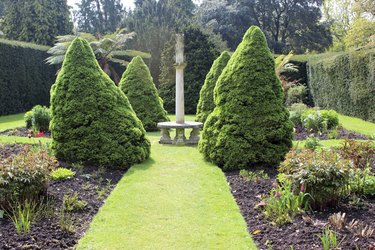
For most U.S. gardeners, the name Alberta spruce is synonymous with dwarf Alberta spruce (Picea glauca variation albertiana "Conica"), one of the country's most widely grown conifers. Compact and slow-growing, dwarf Alberta spruce is at home in formal foundation plantings, mixed gardens and even container-grown topiary. Don't be fooled by slow growth and a name; the tree's dwarf status is relative. Finding the right spot for dwarf Alberta spruce requires forward thinking.
Climate Preferences
Video of the Day
Climate is the first consideration when selecting the perfect planting site for dwarf Alberta spruce. The tree was discovered in an Alberta, Canada, forest and runs true to its northern roots. Dwarf Alberta spruce descends from the western white spruce (Picea glauca variation albertiana), native to the Canadian Rocky Mountains. Like its parent, dwarf Alberta spruce is hardy from U.S. Department of Agriculture plant hardiness zones 2 through 6, where winters provide a true period of dormancy. Heat, humidity and lack of winter cold work against it farther south in the eastern United States, but it also is hardy through USDA zone 8 in the West.
Video of the Day
Room for Growth
Dwarf Alberta spruce doesn't come close to its 100-foot-plus parent, but it has the potential to grow to a height of 10 to 13 feet with a 7- to 10-foot spread. At a rate of just 3 to 4 inches per year, it takes 25 to 30 years to mature fully. When planting dwarf Alberta spruce trees, allow for their mature size, as well as extra room between the trees and their surroundings, or plan to replace the trees as they age. Dwarf Alberta spruce has very dense, uniform growth that needs good air circulation. Its fragrant, finely textured, 1/2-inch-long needles are soft enough to be near walkways. The tree rarely produces cones; so litter is not a concern. Its slow-growing roots are shallow, but they pose no danger to foundations or sidewalks.
Sun, Soil and Shelter
Dwarf Alberta spruce grows best in a site with full sun or filtered midday shade and well-drained but consistently moist mineral soils. In cold areas, the tree is vulnerable to damage from drying winter winds. A planting site with eastern exposure will protect your trees from strong winds and afternoon sunlight. Their shallow roots will make planting the trees simple. Dig each tree's planting hole the same depth as the tree's root ball and two to three times its width. Double-check your spacing allowances for the tree's mature size, and then center the tree in the hole and fill the remainder of the hole with native, unamended soil. Water the area deeply, and apply 2 to 4 inches of organic mulch on top of the soil, helping to keep it moist.
Cultivars' Similarities and Differences
Several cultivars that arose directly from dwarf Alberta spruce share its slow growth habit and potential to outgrow their garden space. "Rainbow's End" Alberta spruce (Picea glauca "Rainbow's End") grows 3 to 6 inches per year. A flush of summer growth covers its light-green foliage in bright yellow. "Jean's Dilly" Alberta spruce (Picea glauca "Jean's Dilly") grows about 2 inches per year. Its needles have a distinctive twist. "Sanders Blue" Alberta spruce (Picea glauca "Sanders Blue") is a tapestry of colors, varying from green to bright slate-blue. These West Coast discoveries are hardy from USDA zones 4 through 8 and require the same planting considerations as dwarf Alberta spruce.
- The Arnold Arboretum of Harvard University: Dwarf Alberta Spruce
- U.S. Department of Agriculture, Natural Resources Conservation Service: White Spruce
- The National Gardening Association: Dwarf Alberta Spruce
- Iseli Nursery: Picea -- Abies to Polita
- Missouri Botanical Garden: Picea Glauca
- Mustila Arboretum: Picea Glauca Var. Albertiana -- Alberta (White) Spruce